| OCTOBER 2013 |
|
4 shows in T˘ky˘ (Kabukiza, National Theatre, NHK Hall), 2 in Nagoya (NTK Hall), 2 in ďsaka (Sh˘chikuza), 1 in Ky˘to (Minamiza) and 1 tour (Classics Tour)!
|
| Kabukiza (T˘ky˘) |  |
| Dates | 1 ~ 25 October 2013 (Kokera Otoshi Geijutsusai Jűgatsu ďkabuki) Opening Ceremony Art Festival October Grand Kabuki |
| MatinÚe |
|
| Evening |
|
| Casting |
Onoe Kikugor˘, Kataoka Nizaemon, Nakamura Kichiemon, Sakata T˘jűr˘, Nakamura Tokiz˘, Nakamura Baigyoku, Onoe Kikunosuke, Nakamura Shibajaku, Kataoka Takatar˘, Kataoka Gat˘, Kataoka Hidetar˘, Nakamura Kinnosuke, Onoe Sh˘roku, Ichikawa Danz˘, Nakamura Karoku, Band˘ Hikosabur˘, Band˘ Takesabur˘, Nakamura T˘z˘, Nakamura Matagor˘, Kawarasaki Gonjűr˘, Band˘ Shűch˘, Nakamura Baishi, Nakamura Kash˘, Band˘ Kamesabur˘, Band˘ Kametoshi, Nakamura Tanenosuke, Nakamura Hayato, Nakamura Yonekichi |
| Comments |
8th month celebrating the opening of the new Kabukiza within a 1-year long cycle of kokera otoshi programs. October at the Kabukiza features a full-length performance of one of the great classics of Kabuki, "Yoshitsune Senbon Zakura" (Yoshitsune and the Thousand Cherry Trees). This is an epic story about the famous 12th century general Yoshitsune fleeing from the wrath of his brother Yoritomo, after the end of the war. Although Yoshitsune is the title character, the main characters of the play are actually Tomomori, Gonta and Tadanobu, the heroes of the different sections of the play. This month's production features top stars in all of these roles, with Nakamura Kichiemon as the boatman Ginpei, actually the great general Tomomori who appears as a fearsome ghost, Kataoka Nizaemon as Gonta, the villainous son of a sushi shop owner, and Onoe Kikugor˘ as the magical fox Tadanobu (in most scenes). Yoshitsune is performed by Nakamura Baigyoku in most scenes. Also featuring Sakata T˘jűr˘ and Nakamura Tokiz˘ in key roles.
|
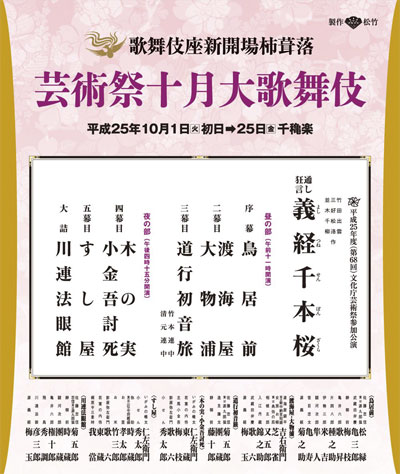 |
| National Theatre (T˘ky˘) |
| Dates | 3 ~ 27 October 2013 |
| Program |
|
| Casting |
Matsumoto K˘shir˘, Ichikawa Sadanji, Nakamura Kaishun, Ichikawa Somegor˘, Ichikawa Emiya, Ichikawa Komaz˘, ďtani Tomoemon, Matsumoto Kingo, Sawamura S˘nosuke, Nakamura Matsue, ďtani Hirotar˘, ďtani Hiromatsu, Matsumoto Kintar˘, Ichikawa Danko, Nakamura Umemaru |
| Comments |
|
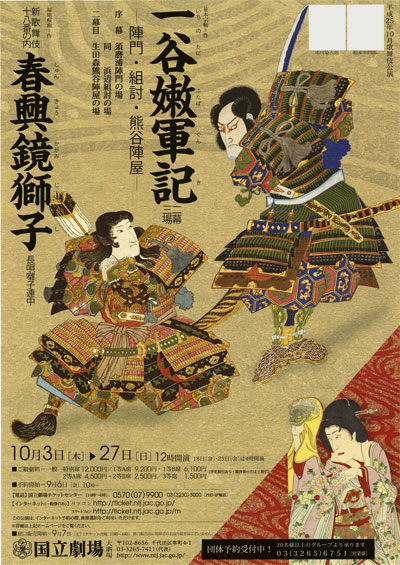 |
| Nagoya (NTK Hall) |
| Dates | 5 ~ 27 October 2013 (Kinshű Nagoya Kaomise) Autumn Brocade Nagoya Face-Showing Program |
| MatinÚe |
Yowa Nasake Ukina no Yokogushi (Kirare Yosa)
|
| Evening | |
| Casting |
Nakamura Hashinosuke, Nakamura Senjaku, Nakamura Fukusuke, Band˘ Yajűr˘, Ichikawa Monnosuke, Kataoka Kamez˘, Ichimura Manjir˘, Nakamura Utae, ďtani Keiz˘, Nakamura Kotar˘ |
| Comments |
The October kaomise programs in Nagoya. As the Misonoza closed in Spring 2013, these programs are staged at the Nihon Tokushu T˘gy˘ Shimin Kaikan, a venue commonly called NTK Hall in Nagoya.
|
 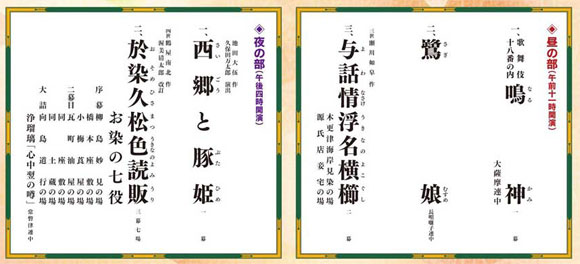 |
| Sh˘chikuza (ďsaka) |
| Dates | 3 ~ 27 October 2013 (Jűgatsu Hanagata Kabuki) October Young Actors Kabuki |
| MatinÚe |
Shin Abura no Jigoku - ďsaka Junj˘den Sannin Renjishi |
| Evening |
|
| Casting |
Kataoka Ainosuke, Nakamura Kanjaku, Nakamura Kikaku, Band˘ Shinsha, Kamimura Kichiya, Ichikawa Omez˘, Ichikawa En'ya, Nakamura Mantar˘, Band˘ Shingo, Onoe Ukon, Nakamura Kazutar˘, Kamimura Kichitar˘ |
| Comments |
|
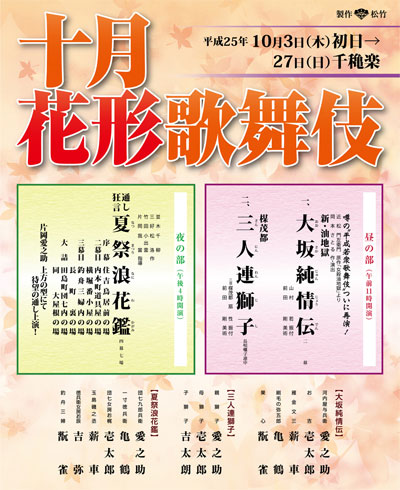 |
| Classics Tour | |
| Dates | 5 ~ 27 October 2013 (Koten he no Izanai ~ Edo no Hana) Invitation to the Classics ~ Edo Flowers |
| Program |
Opening Talk |
| Casting | |
| Comments |
An original tour, which mixes talk, music and dances. The second item is the music of the dance "Tamaya", which is performed by Kiyomoto Kikusuke's Kiyomoto ensemble. The third and fourth item are dances performed by Ichikawa Ebiz˘. The opening talk is done by the young Kabuki star Ichikawa Ebiz˘.
|
| NHK Hall (T˘ky˘) | |
| Dates | 29 October 2013 (Koten Gein˘ Kansh˘ Kai) |
| Program | |
| Casting |
Nakamura Baigyoku, Nakamura Shibajaku, Kataoka Gat˘, Kataoka Shinnosuke, Band˘ Kamesabur˘, Nakamura Kamenoj˘ |
| Comments |
40th edition of Koten Gein˘ Kansh˘ Kai (literally the "Classics Entertainment Appreciation Association"), a yearly performance produced by the National TV network NHK. The program includes one ky˘gen, one Kabuki play, one traditional dance and traditional music.
|
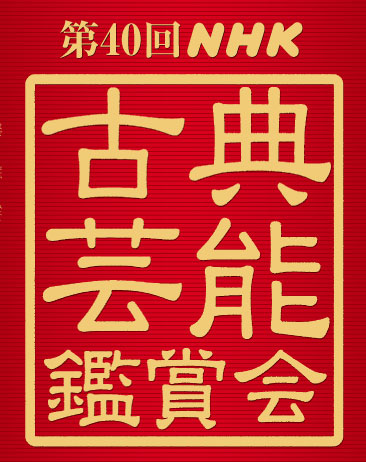 |
|
|||
| Dates | 5 ~ 27 October 2013 (Band˘ Tamasabur˘ Tokubetsu K˘en) Band˘ Tamasabur˘ Special Performances |
||
| Program |
Amaterasu |
||
| Casting | |||
| Comments |
Living National Treasure Band˘ Tamasabur˘ and the Kod˘ taiko drummers revive "Amaterasu", which was staged for the first time in May 2006 at the Minamiza [more details]. |
||
|
|
| Contact | Main | Top | Updates | Actors | Plays | Playwrights | Programs | Links | FAQ | Glossary | Chronology | Illustrations | Prints | Characters | Derivatives | Theaters | Coming soon | News |